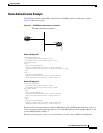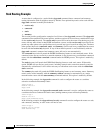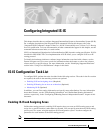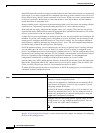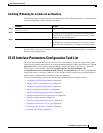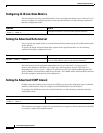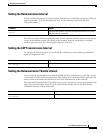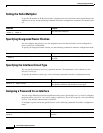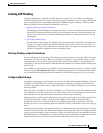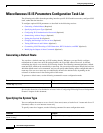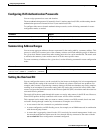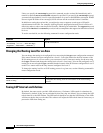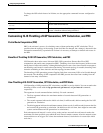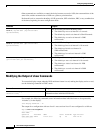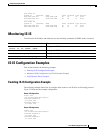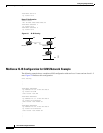
Configuring Integrated IS-IS
IS-IS Interface Parameters Configuration Task List
IPC-283
Cisco IOS IP Configuration Guide
Limiting LSP Flooding
Limiting LSP flooding is important to IS-IS networks in general, and is not limited to configuring
multiarea IS-IS networks. In a network with a high degree of redundancy, such as a fully meshed set of
point-to-point links over a nonbroadcast multiaccess (NBMA) transport, flooding of LSPs can limit
network scalability. You can reduce LSP flooding in two ways:
• Blocking Flooding on Specific Interfaces
The advantage of full blocking over mesh groups is that it is easier to configure and understand, and
fewer LSPs are flooded. Blocking flooding on all links permits the best scaling performance, but
results in a less robust network structure. Permitting flooding on all links results in poor scaling
performance.
• Configuring Mesh Groups
The advantage of mesh groups over full blocking is that mesh groups allow LSPs to be flooded over
one hop to all routers on the mesh, while full blocking allows some routers to receive LSPs over
multiple hops. This relatively small delay in flooding can have an impact on convergence times, but
the delay is negligible compared to overall convergence times.
Blocking Flooding on Specific Interfaces
You can completely block flooding (full blocking) on specific interfaces, so that new LSPs will not be
flooded out over those interfaces. However, if flooding is blocked on a large number of links, and all
remaining links go down, routers cannot synchronize their link-state databases even though there is
connectivity to the rest of the network. When the link-state database is no longer updated, routing loops
usually result.
To use CSNPs on selected point-to-point links to synchronize the link-state database, configure a CSNP
interval using the isis csnp-interval interface configuration command on selected point-to-point links
over which normal flooding is blocked. You should use CSNPs for this purpose only as a last resort.
Configuring Mesh Groups
Configuring mesh groups (a set of interfaces on a router) can help to limit redundant flooding. All routers
reachable over the interfaces in a particular mesh group are assumed to be densely connected (each
router has many links to other routers), where many links can fail without isolating one or more routers
from the network.
Normally, when a new LSP is received on an interface, it is flooded out over all other interfaces on the
router. When the new LSP is received over an interface that is part of a mesh group, the new LSP will
not be flooded out over the other interfaces that are part of that same mesh group.
Mesh groups rely on a full mesh of links between a group of routers. If one or more links in the full mesh
go down, the full mesh is broken, and some routers might miss new LSPs, even though there is
connectivity to the rest of the network. When you configure mesh groups to optimize or limit LSP
flooding, be sure to select alternative paths over which to flood in case interfaces in the mesh group go
down.
To minimize the possibility of incomplete flooding, you should allow unrestricted flooding over at least
a minimal set of links in the mesh. Selecting the smallest set of logical links that covers all physical paths
results in very low flooding, but less robustness. Ideally you should select only enough links to ensure
that LSP flooding is not detrimental to scaling performance, but enough links to ensure that under most
failure scenarios no router will be logically disconnected from the rest of the network.



